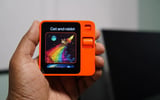Rabbit's New Teach Mode Revolutionizes Home Automation with Natural Language Task Training
November 21, 2024
Rabbit's CEO, Jesse Lyu, highlighted the potential of Teach mode to automate complex multi-platform tasks, such as grocery ordering using a camera for shopping lists.
Users can automate tasks by performing them normally while the R1 records these interactions, which can then be replayed and executed by the device.
Rabbit has introduced a new feature called Teach mode for its R1 device, allowing users to teach it actions through natural language descriptions.
This significant beta feature follows over 20 software updates and is designed to automate tasks across various websites, including popular platforms like Spotify, X, YouTube, and Discord.
The R1 also aims to streamline interactions with competing smart home standards, addressing existing challenges in smart home automation.
Teach mode is part of a broader enhancement strategy for the R1, which recently integrated a large action model (LAM) to improve website navigation.
Currently, users have access to a limited number of lessons or can create their own, as the app store is not yet launched and monetization strategies are still being developed.
Looking ahead, Rabbit envisions a marketplace for users to sell their automations, similar to existing app stores, although it remains uncertain if users will pay for community-created lessons.
Despite facing challenges in a competitive AI market, Lyu remains optimistic about the future of Rabbit and the R1, emphasizing the importance of user feedback in ongoing product development.
To train the AI, users log into the Rabbithole web interface, where they can describe tasks and demonstrate how to complete them.
Once a task is taught, users can request the AI to recall the lesson and perform the task, enhancing user interaction with the device.
Teach mode is accessible through the Rabbithole hub, requiring users to log into their Rabbit account to input credentials for the websites they wish the R1 to automate.
Summary based on 3 sources


